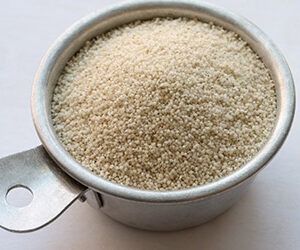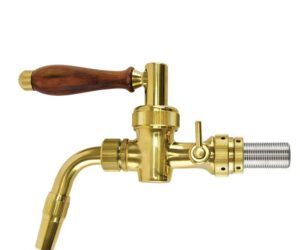Protein Rests, Freeze-Drying Yeast, & Simplifying Homebrewing
Q I would like to know if I should do a protein rest for grain bills with over 25% wheat. I have heard conflicting advice and cannot seem to get a clear answer either way.
Richard Bray
Omaha, Nebraska

A This is a great question, Richard. The short answer is no, you do not need to do a protein rest when brewing with more than 25% wheat. However, many brewers want to use a protein rest for several reasons. To give this question a proper discussion I will briefly differentiate raw wheat from malted wheat, touch on what “the protein rest” means to the practical brewer, and finish with why brewers may choose to use this rest when brewing wheat beers.
When it comes to brewing with wheat, there are four main types: Raw wheat, flaked wheat, torrefied wheat, and malted wheat. Raw wheat is what comes out of the field when wheat is harvested and threshed to separate the wheat berry from the husk and stem. Flaked wheat is produced by steaming then smashing wheat berries into flat bits, whereas torrefied (or torrified) wheat is produced by using radiant energy to intensely heat and puff wheat berries. Both processes partially gelatinize wheat starch. Torrefied wheat has more flavor than flaked wheat and can also be flaked after torrefication, making it difficult to know which flakes are steam-rolled and which are torrefied. Malted wheat is hydrated through steeping, germinated, and kilned like other malted grains.
The primary differences between the three unmalted wheat types and malted wheat, is that the unmalted types contain undegraded cell wall material, lack alpha amylase and other enzymes developed during germination, and are exposed to minimal heat during processing. In practical terms this means that the unmalted types may lead to difficult wort separation due to beta-glucans, will dilute malt enzymes in the mash, and dilute “malty” flavors associated with malted grains. And because wheat usually contains more protein by weight than barley, unmalted and malted wheat types contribute more protein to wort than malted barley. It’s also important to recognize that wheat, unlike barley, loses its husk when “combined” or harvested.
Let’s take a break from stating facts and look at the protein rest using more specific terms. The protein rest is used to reference mash temperatures in the 113–131 °F (45–55 °C) range. Originally named for the increase in amino acids measured after mashing in this temperature range, the protein rest is not just about protease activity. Lipoxygenase, beta-glucanase, arabinoxylanase, and ferulic acid esterase are other enzymes active at these cooler mash temperatures. Depending on a brewer’s intent for using a low temperature rest, different names may be used to describe the same rest.
Using unmalted grain and want to avoid headaches associated with beta-glucans? Consider using a “beta-glucanase rest.” Want to boost the clove-like aroma of your summer hefeweizen? Extend that “ferulic acid rest.” Or are you looking to boost the amino acid content of your rice lager wort? Time to drop in a “protein rest.” But if you are brewing with lightly kilned malt, beware of lipoxygenase activity at lower mash temperatures because it can lead to the development of wet paper aromas from the formation of trans-2-nonenal (now E-2-nonenal because of changes in stereochemical nomenclature).
Now it’s time to dig into your question. Should you use a protein rest when using wheat? The official answer has changed; it’s now “it depends.” First, why are you using wheat in your beer? And are you using unmalted wheat or malted wheat?
Let’s assume you are using unmalted wheat because it’s great for beer foam, is relatively easy to use, adds a nice snap to lighter-colored beers, like wit, and is a good source of protein for the hazy beers. These goals can all be achieved without the protein rest. However, you may run into an issue with wort separation because unmalted wheat contains undegraded cell walls that are rich in beta-glucans. Adding a rest around 113 °F (45 °C) may be something to consider because this temperature is ideal for beta-glucanase activity. You will also have other enzymes active at this temperature and need to be aware of what they may do for your brew. If you are looking to reduce wort viscosity and improve run-off and yield, the pros are likely to outweigh the cons.
Using the same basic example, consider a problem where extract yield is low when using 40% unmalted wheat and a single temperature mash. One explanation is that the beta-glucans and high-molecular proteins that bind starch granules into the matrix of the endosperm need to be digested. We’re back to another benefit of using a low-temperature rest in the 113–131 °F (45–55 °C) range. But low yield also occurs with poor conversion, i.e., failure of the iodine test to show a negative reaction. Incomplete conversion can be caused by enzyme dilution, and adding a protein rest won’t fix that.
I am a big fan of hefeweizen and will finish this discussion with an example using malted wheat instead of unmalted wheat because German brewers only use malt. If we want to give plenty of ferulic acid for weizen yeast to convert into 4-vinyl-guiacol, the best thing to do is mash in where ferulic acid esterase can do its thing by freeing up ferulic acid from arabinoxylans. Again, we are back in the same temperature range. Adding a 30-minute rest at 113 °F (45 °C) is a technique used by weizen brewers to boost clove notes.
Some brewing questions lack clear answers because there is no single way to tackle the problem. But when it comes to questions about the protein rest, things become murky because the term we use to describe rests in the 113–131 °F (45–55 °C) range are not about a single topic. With that, Richard, it’s time to brew with wheat!
Q I feel like homebrewing has gotten overly complicated. I read that you are still using glass carboys. What “simplifications” do you recommend that will bring the joy back?
Brian Knight
Tampa, Florida
A This is a fun question that probably has more than a few people questioning my wisdom over the use of glass carboys. Just to be clear, I keep mine in a crate and am very careful when handling. I’ll touch on this topic later but wanted to address the elephant in the room as disasters caused by broken glass carboys should he taken seriously! So, you feel homebrewing has become too complicated? Based on your reference to my use of carboys, I assume you are referring to the high-zoot equipment that seems to come in all shapes and sizes these days and will focus my discussion on simplifying equipment.
Wort production is the area that seems to bring out the gadgets more than others, be it at home or in commercial breweries. There is no denying the beauty of both the classic copper and the modern stainless steel brewhouse. And when it comes to techno-centric homebrewing, mash tun, brew kettle, and hot water tanks are often mounted on frames or stands with pumps, valves, pipes, hoses, instruments, and fancy heaters. Some brewers love this sort of thing and see lots of flexibility with process and endless concoctions waiting to be prepared, while others see dollar signs, lots of stuff to clean, and a setup that requires ample space in the home or garage.
When I hung up my commercial brewing boots in 2020, I walked away from an automated 15-BBL brewhouse with loads of flexibility. And when I began homebrewing again I built an old-school setup using a cooler for a mash tun, a cooler for a hot water reservoir, and a propane-heated kettle as my sole heating source. While this equipment is simple, the propane flame pushed me outdoors and I found that my setup and cleanup times took too long. A few years ago, I moved away from coolers and began using an all-in-one Grainfather system along with an electrically heated hot water reservoir. These systems are not as basic as a cooler, but they are simple to use and clean, can be used indoors, and don’t require much storage space. At the end of the day, my current system is much simpler than my old-school system.
Although wort production is where the big, showy stuff is usually seen, homebrew fermenters that mimic commercial tanks have always looked like overkill to this simple brewer. Not only do stainless steel fermenters require a larger financial commitment, they are usually coupled with a refrigeration system. And just like shiny, big brewing systems, they offer a lot of flexibility when it comes to temperature control during fermentation and aging, allow brewers to easily harvest yeast, make beer transfers simple, and can be cleaned-in-place given the right pump and spray device. I cannot imagine not having this sort of equipment in a commercial operation, but personally find all of this too much for my homebrewing setup.
Call me a troglodyte, but I love fermenting in glass carboys. I can see what’s going on and don’t feel the need to frequently pull samples because old dudes like me have seen enough fermentations to have a good idea of things without taking many measurements. I also like the simplicity of cleaning by using a mild detergent, a modest amount of elbow grease, and the ability to easily see areas that are not clean. The problem with glass is that it’s relatively heavy and can break. The good news is that plastic carboys, fermentation buckets, and cone-bottom fermenters are all available for those who don’t want to deal with glass.
The two challenges that these types of fermenters all present is temperature control. The simplest approach is to ferment in a basement with a cool and consistent temperature using yeast strains that work well in the environment. If you don’t have a cool space and/or more flexibility with yeast strain selection, you are going to want some sort of cooling system. Last year I played around with a MacGyver-version of a swamp cooler using a plastic basin (new litter box), a fan, temperature controller, water, and two paper towels. By placing my carboy in the basin, adding several inches of water, taping the paper towels to the side of a carboy where the bottom is submerged in the water, taping the probe of the controller to the backside of the carboy (I cover it with insulation so that it only senses the carboy temperature), and controlling the fan, I am able to keep my fermentations a couple of degrees below ambient. Gotta admit, this rig is my pride and joy!
The end of my process is super simple. I prepare a keg for use by first filling with StarSan and pushing it out with carbon dioxide. When I am ready to rack, I attach a black ball-lock fitting to my racking hose, open the bleed valve on the keg lid, and rack. Zero concerns about oxygen introduction because the system is completely filled with carbon dioxide. And if you are worried about the air in the racking hose you can crack open the ball-lock fitting, start the siphon, and tighten the fitting before attaching it to your keg. I’m also one of those thick-skulled brewers who racks more than once because I work in the commercial brewing world where this practice is still common, despite what the homebrewing pundits in the cyberworld say about the pointlessness of serial racking. Once my keg is full, I pressurize the headspace, toss it into my beer cooler, and force carbonate after it has chilled for about a day. Bottling is not something I enjoy doing, so I rarely bottle. When I do, I use a counter-pressure filler.
Other ideas on simplifying homebrewing include purchasing pre-milled malt, using dried yeast or liquid yeast that does not need to be propagated, and not getting too hung up about step or decoction mashing unless there is a compelling reason to do something other than an infusion. Don’t pay much attention to the hype surrounding pressure fermentation, it’s not a new thing and it does not work miracles. Use Gordon Strong’s approach to brewing water (starting with reverse osmosis water and making simple adjustments) rather than brushing up on water chemistry and going gonzo with water calculations. Last but not least, spend more time enjoying the beer you and your brewing friends brew and less time talking about equipment.
Q I read an article on saving yeast and started to think about long-term storage. I have a small freeze dryer from Harvest Right that I use for storing food for camping and hiking. Those foods rehydrate pretty well. What are your thoughts on actually freeze-drying, not just freezing, the yeast for use later on? Do you think it will work or has anyone tried this at home?
Don Foster, Via email
A Freeze-drying, or lyophilization, has been used for drying bacteria and yeast for nearly 100 years. The process begins by freezing, followed by subjecting the sample to a vacuum. The low pressure results in sublimation, where solid water, aka ice, directly changes phases into water vapor without moving through the aqueous phase; totally sublime. Although freeze-drying works well for food products, it is a stressful process for living cells and tissues. One of the earliest references investigating the application of freeze-drying to brewing yeast is the work of Wickerham and Andreasen of the Wallerstein Laboratory (NYC) in 1942. While brewing yeast can be freeze-dried, two complications are relatively high loss in viability and a change in the population of cells.
A study by Jean Wynants, titled “Preservation of Yeast Cultures by Lyophilization,” published in 1962 in the Journal of the Institute of Brewing showed a population increase in respiratory deficient mutant cells, known as petite mutant, after freeze-drying. Wynants concluded that the freeze-drying process led to low cell survival rate selected for petite mutants, thereby skewing the population of cells after rehydration. He also concluded that freeze-drying requires a selection step following rehydration, then propagation using the standard method of the time where a colony is transferred into a small volume of wort to begin a series of propagation steps. This method is still the norm today.
Freeze-drying is used to preserve yeast and does indeed allow for long-term storage of cells. Many yeast labs around the world send freeze-dried cultures by mail to labs and commercial users (breweries, wineries, bakeries, etc.) because of its convenience. One of the keys to the method is using a lyoprotectant agent to add protection to the culture before freeze-drying. Examples of lyoprotectants include blood serum and disaccharide solutions made from sucrose or trehalose.
You have a freeze dryer and are interested in trying it with yeast. My suggestion is to read more about how this technology is used to dry living cultures and give it a try. The worst thing that can happen is that you end up with dry, dead yeast!



